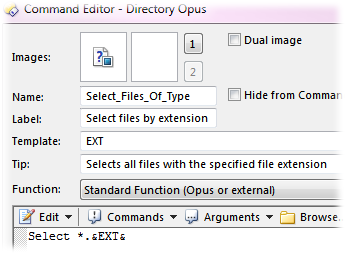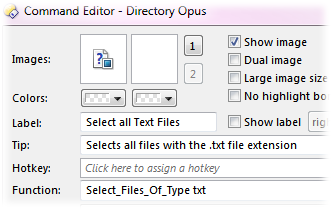
User-defined commands are pre-defined commands that you create yourself. Effectively it's like creating a toolbar button with your own function on it, but instead of the button living on a toolbar, it lives in this command list and other buttons or menus can refer to it by name.
When you create a user command you give it a name (which must be unique and not clash with any of the Opus commands), and other buttons can then run your user command using its name. User commands can also accept parameters (arguments) on the command line, which lets you pass through parameters to external programs or scripts that your user command might invoke.

To create a new user command, double-click the Add new User Command item in the list, or right-click it or the User-defined Commands category header and choose New from the context menu. The context menu is the main way to perform other actions on user commands. If you right-click an existing user command, the commands in the context menu are:
The screenshot above shows an example of a user command in the list. As you can see, the name of the command is Select_Files_Of_Type (command names cannot contain spaces; any spaces are automatically converted to an underscore). Double-clicking that command to open the editor reveals the following configuration:

The user command editor is based on the standard function editor so we won't document fully how to use it here - instead see the Function Editor documentation for a full description. The principle elements of the user command are:
For Windows 7 users, the Jump List Preferences page lets you select
individual user-defined commands that can be added to the Jump List menu. The
Label and Image defined for the command will
be shown in the Jump List.
When I created this user command I wanted a function that would select all files with a given file extension; therefore I needed to use the template field to specify a command line argument that is passed through to the command. This uses the same syntax as for internal Opus commands. In the above example, we only want a single string value. The argument has been given the name EXT in the template field. This is not the value of the argument (that doesn't exist until something uses this user command), but the name of the argument.
The function for the user command, Select *.&EXT&, calls the internal Select command, passing it a wildcard string that is built from the supplied EXT parameter. The argument name is supplied in the function definition surrounded by ampersands (&) which indicates to Opus that the value of that argument is to be inserted in the command line.
So how do we actually use this user command? Well, because it requires a command line argument to do anything, we need to put it on a button or menu (or hotkey) and then edit the function to supply the desired extension. The following button definition would do this; it will select all .txt files in the current file display.

As you can see, we have edited the label and tooltip (description) to one more suited to the actual button we created. The function defined for this button calls our new Select_Files_Of_Type user command, passing it the argument txt. The user command takes the argument and passes it on the command line as described above to the Select command, which then performs the desired action by selecting all files that end with a .txt extension.
In the above example, EXT is a string argument and so the value supplied is passed through unchanged to the user command, but for boolean options the behaviour is different. For example, consider the following user command:
Name: ExampleCmd
Template: EXAMPLE1/S,EXAMPLE2/O
Function: C:\DummyProgram.exe &EXAMPLE1& &EXAMPLE2&
The ExampleCmd user command will run the C:\DummyProgram.exe program when it's invoked. Its template has two boolean options, EXAMPLE1 (a straight switch argument, either on or off), and EXAMPLE2 (an option switch argument, which can be off, on or have a string value supplied). By default, a switch argument will insert the value 1 when it is set, and 0 when it isn't. For example, the following use of the user command would produce the following command line for DummyProgram:
Command: ExampleCmd EXAMPLE1
Runs: C:\DummyProgram.exe 1 0
However, you can use the &..& insert to specify the actual strings that are passed through for that argument. For example:
Function: C:\DummyProgram.exe &EXAMPLE1:yes:no& &EXAMPLE2:one:two&
Command: ExampleCmd EXAMPLE2
Runs: C:\DummyProgram.exe no one
For option switch (/O) arguments this only applies if the argument has been used as a switch, and not to provide a string value - if a string value is supplied instead, it is passed through unchanged. For example:
Command: ExampleCmd EXAMPLE1 EXAMPLE2=test
Runs: C:\DummyProgram.exe yes test
Your template can also specify a list of values for an option switch which will then be shown in the drop-down list in the advanced command editor, making it easy to pick the value for the argument. If you use this, you can also specify a default value, which will be passed through if a value is not given for the option. Consider the following template and the two example uses:
Name: ExampleCmd
Template: EXAMPLE/O[<default>,one,two,three]
Function: C:\DummyProgram.exe &EXAMPLE&
Command: ExampleCmd EXAMPLE
Runs: C:\DummyProgram.exe default
Command: ExampleCmd EXAMPLE=two
Runs: C:\DummyProgram.exe two